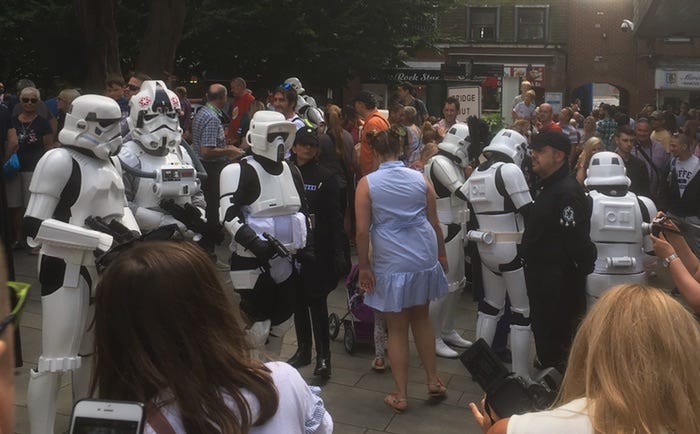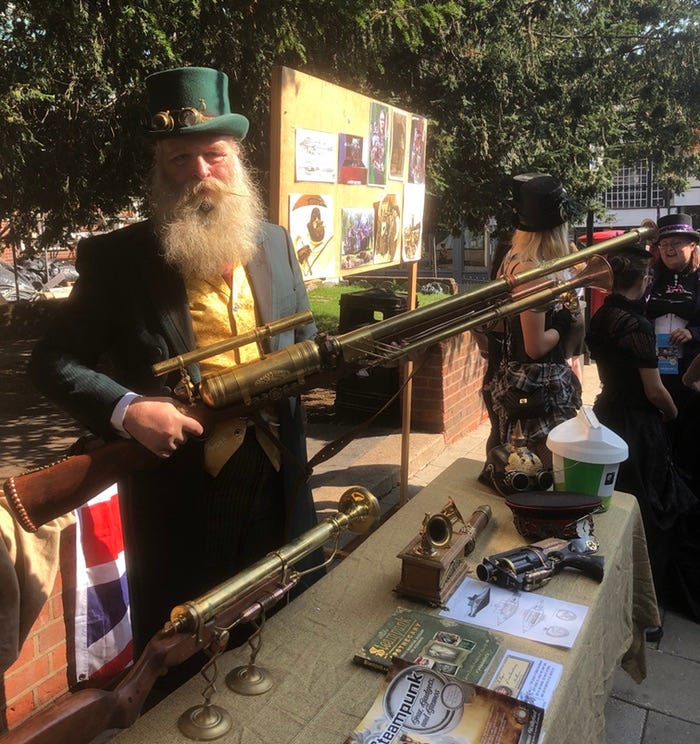In this episode we explore how it’s wise to be aware of when we’re doing more than just playing a role…
Okay, so this weekend I went to the Melbourne Comic-Con. For my part, I was there mainly to do market-research for my Viner Codex series of novels, though we can talk about that some other time. The point here was that whilst there was a lot there about graphic-novels and artwork and the like, which was my main area of interest, probably what most were really there for was all the cosplay - dressing up as a favourite character in some movie, anime, manga or graphic-novel or a broader genre such as steampunk or historical reenactment, and then at least somewhat playing that respective part.
There were strict rules about photography at the event, so I don’t have any photos from there. But you can get the basic idea from this one that I took at Invasion Colchester, a big annual cosplay-event in my old home town, that acts as a fundraiser for local hospitals:
…and another photo of a steampunk-friend at the same festival with his supposed ‘dinosaur gun’:
Why do people do this stuff? Part of it is, yeah, because it’s fun - I mean, I’ll freely admit I’ve done the steampunk bit myself a couple of times now, at least to the extent of wearing the obligatory bowler hat with the obligatory goggles and carrying my big bass-flute-with-a-big-bend-in-it over my shoulder as if it’s some kind of portable cannon:
But for the serious cosplay folks, it’s a lot more than just fun: it’s more like a way of life, a key part of their identity, formed, oddly, by taking on someone-else’s identity, even if that ‘someone else’ would typically be a fictional character. Take a look at the Japanese anime ‘My Dress-up Darling’, for example, if you’d like to get some idea of the intensity and passion involved in that kind of world. Yeah, it’s serious, all right…
And it’s there that this starts to touch upon our concerns here about big-picture change and the like. Yet to make sense of that, we need first to take a brief diversion into a domain that’s not that far distant from cosplay, namely improv theatre, to explore the concept and experience of Mask.
The practice of Mask has been around for millennia, taking on many different forms in various different parts of the world across the centuries. The best description I’ve seen of it is in the later part of Keith Johnstone‘s now-classic book ‘Impro: Improvisation and the theatre’, so I’ll do a bit of a summary from there.
In most cases, a straightforward full-face mask is not complicated: in most cases, people know they’re acting a role, and the mask is simply a front for that role. But for some types of mask - particularly a half-face mask, dividing the face either horizontally, as in the classic ‘villain’-mask, or vertically, as in The Phantom of the Opera - it often has an effect that, is, well, kind of weird, to say the least. That’s why Keith Johnstone insisted on using the capital-’M’ to distinguish it: ‘Mask’, rather than just plain ‘mask’.
The simplest way to summarise it would be to say that there’s an interaction between the person and the Mask - and the Mask has choices too. (Note that the term ‘choices’ is more a metaphor here than about some kind of seriously-weird conscious-intent. Well, mostly so, anyway, though a few cases might advise some doubt on that…? :wicked-grin: ) Unlike the usual full-face mask, what happens with a Mask isn’t just an act: the person’s entire personality can change whilst they’re wearing that Mask - and different people will show the same behaviour-shift whilst wearing that same Mask. And we can’t necessarily predict the behaviour shift just from the shape or surface-appearance of a given Mask. I know that sounds more than a bit weird, but it really does work that way: do read that section on Mask in Impro if you need more detail.
So far, so straightforward, even if a bit weird. But this is where it gets weirder again, because it doesn’t just apply to actual masks: what I’ve seen in practice is that a whole load of other things can also act as a Mask. In effect, this is the whole point about cosplay: the costume itself acts as a Mask, making it easier to take on the role and characteristics of the character symbolised by the costume. And - importantly! - be able to let go of the character again when the costume is taken off.
And this Mask effect doesn’t just apply in theatre and the like: I’ve seen that it can - and often does - apply in just about any type of context, in just about anywhere. Consider a formal uniform, for example: one of the more amusing aspects of the Invasion Colchester event was that it often became difficult to tell the difference between the actual police and those who were just cosplaying police, or - because Colchester is a garrison town - between those who were cosplaying soldiers versus the actual soldiers. But the real uniform itself can and often does have real Mask-type effects on the real people who wear that uniform, as the character Anton (Antonia) describes in my 1880s sci-fi novel The Viner Journey:
Strange how a change of clothes changes everything. I love how I feel in uniform, I feel stronger straight away, more professional, more me. Especially with the trews, rather than that ridiculous regulation skirt. But odd that I need to dress like a man to feel more my own woman - especially, as here, amongst other women I don't know.
Not just military-type uniforms either: the same happens with business-uniforms, too. For example, there’s that apocryphal tale that new IBM employees would have fundamental shifts in mindset and more within less than a day of putting on that infamous blue suit - and I’ve seen hard-data about IBM and other large organisations that strongly suggests it’s more than just an apocryphal tale…
And so many other things that can work the same way - that can act as a Mask in much the same way. Places and landscapes can do this: I wrote about that almost fifty years ago in my book ‘Needles of Stone’, that “there is an interaction between people and place - and the places has choices too” (hence that paraphrase about Masks earlier above. It doesn’t even need to be something physical, either: brands can do it; ideologies can do it; religions can definitely do it; almost by definition, the Mask of a cult will do it, often in a truly devastating way. Not A Good Idea?
If you want to see this effect first-hand, notice what happens when you’re out somewhere with your family, and you accidentally meet up with someone more senior from your workplace. Often completely disorienting, right? That’s because there’s a clash of Masks: the world and worldview of you within your family, the Mask of ‘family’, versus the ‘you’ that you become and are at work, the Mask of ‘employee’ or ‘professional’ or ‘subordinate’ or whatever.
Then take a look at all the different Masks around you out there. Lots and lots and lots of them. Just about anything - maybe even almost everything? - can become a Mask, if we’re not careful. Each of them imposing their ‘choices’ upon us, if we’re not careful.
So the opposite point applies here too: yes, a Mask has its own implied, built-in metaphoric choices, but so do we - and we need to exercise our choices well, and choose to assert those choices of ours, too.
Perhaps the most important choice is to know when we’ve taken on a Mask, and also, importantly, when and how to take it off. Most cosplayers do know when they’re putting on the Mask of their costume, and do know how let go of its Mask-effects when they take the costume off again at the end of the day. But yeah, some don’t - and can’t let go of that Mask even when they’re no longer wearing the costume. Kind of sad when we see that happen. But even more sad when we take a long, careful look around us, at how so many people have become trapped by some or other other Mask out there, such as the Mask of paediarchy, the Mask of ‘rights’, the Masks of possessionism and the money-’economy’, the Masks of so many political and religious and other cults - and don’t know how to let go of them, no matter how destructive those Masks have become to their own lives, to everyone’s life. Yeah, sad. Sad indeed.
Not always sad, of course. Masks can be good; Masks can be supportive; Masks can helpful, particularly in guiding some kinds of change. But if we don’t understand how Masks work, and don’t take care about that interaction, then yeah, just about any Mask we come across can end up controlling us - and we won’t even be aware that it’s happening. Not A Good Idea…
So let’s do a summary here. The Mask-effect may be weird, but it’s also real: sometimes dangerously real, capable of getting us to cause real harm even at very large scale. So yes, we do need to be aware of the Mask effect; we need to understand how Masks work, and how they can affect us; we need to be able to identify when we’re caught up in a Mask; we need to be able assert our own choices whenever we’re caught up in any Mask-effect; and we need to be able to extricate ourselves from any Mask at any moment, too. More would no doubt help, but even that alone should be enough to at least get us out of any Mask-type trouble that we might fall into as we go along.
This ain’t just cosplay, folks: we need to choose our Masks with care.




The relationship between persona, myths and the unconscious provide reams and reams of material for discussion. Joseph Campbell dealt with this particularly well. I also wonder whether activities like cosplay become the outward reflection of an inner reaching for a value set which is bound in the costume itself. So many young men and women, for example, seem to seize on "The Force" as a set of values in which to immerse their real life, and which emerges in cosplay as a Jedi Knight. Another complete aside which I just started thinking of - so often an individual work desk is an expression of that inner life. The desk itself becomes a form of cosplay which is acted out in a socially acceptable way. Its very easy to pick the Star Wars fanatic for example - a persona one frequently encounters in software dev teams..
Its a fascinating piece of study to ready, for example, Jung on the relationships between masks and personas. That observation about meeting a senior person from your workplace in a casual setting is a great example of that. Whilst one has the persona of father and husband, to meet that senior person leaves one with the option of either changing the persona to the workplace one, or allowing the senior manager to see the father/husband persona. And - importantly, the senior person has exactly the same choice to make...